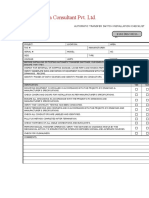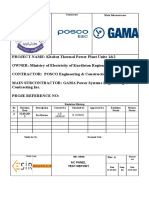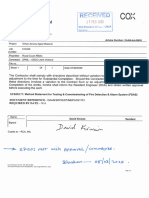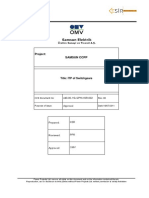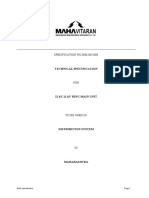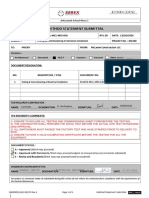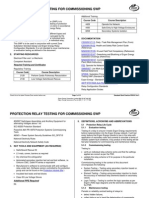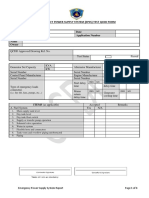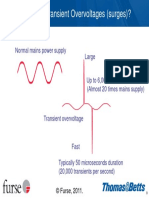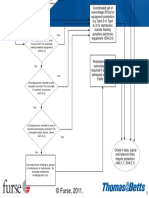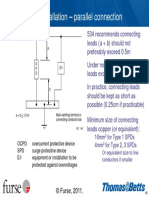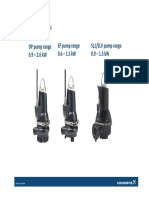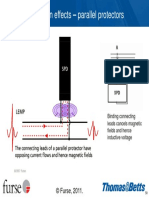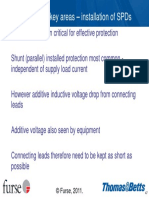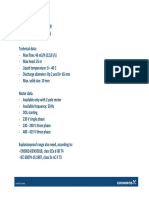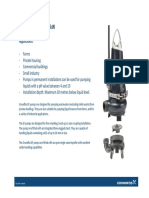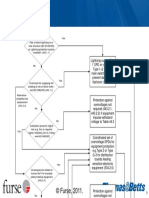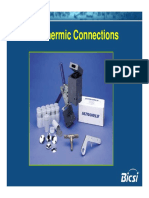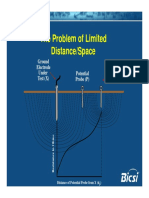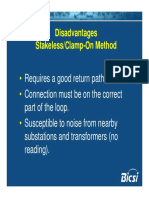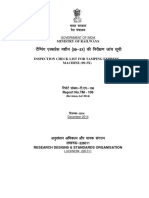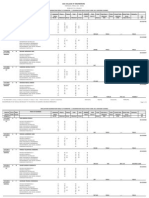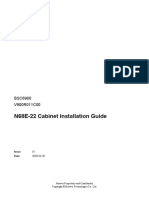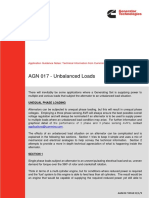11/28/2017 Automatic Transfer Switch & Bypass Isolation Switch Method of Testing & Commissioning - Method Statement HQ
Automatic Transfer Switch & Bypass Isolation Switch Method of
Testing & Commissioning
Electrical Method Statements, Method Statements, Testing & Commissioning 301 Views
The purpose of this method statement is to outline the sequence & method of Testing & Commissioning of
Automatic transfer & Bypass isolation switch. This procedure is to be read in conjunction with relevant
operators Manual and Users guide.This procedure ensures the method used for testing and
commissioning of Automatic transfer switch is correct and acceptable.After installing the switch check the
following:
Bypass handle should be in NORMAL position. Isolation handle should be in CONNECTED Position.TS
transfer switch normal contacts should be C (closed). Emergency contacts should be 0 (open). If handles are
not in correct positions, follow instructions for Bypassing and Isolating the Automatic Transfer switch.
Check nameplate on transfer switch. Rated voltage must be the same as Normal & Emergency line voltages.
Use extreme caution when using a meter to measure voltages. Do not touch power terminals. Shock, burns
or death could result.Close the normal source circuit breaker. The transfer switch connected to normal and
the normal source accepted lights should come on. Use an accurate Voltmeter to check phase to phase and
phase to neutral voltage present at the transfer switch emergency source terminals.
Close the emergency source circuit breaker. Start generator
Advertisement: manually.The transfer switch connected to Normal and
Emergency source Accepted lights should come on. Use an
accurate voltmeter to check phase to phase & phase to neutral
voltages present at the transfer switch Emergency source
terminals.
Use a phase rotation meter to check phase rotation of emergency
source. It must be the same as the normal source. Shut down the
generator. The emergency source accepted lights should go off.
Then put generator starting control selector switch in the
automatic position. Close enclosure door.
Transfer Test Procedure
This procedure checks electrical operation of Automatic Transfer switch.
https://methodstatementhq.com/automatic-transfer-switch-bypass-isolation-switch-method-testing-commissioning.html 1/5
�11/28/2017 Automatic Transfer Switch & Bypass Isolation Switch Method of Testing & Commissioning - Method Statement HQ
Be sure to close enclosure door before proceeding to prevent personal injury in case of electrical system
fault. The ATS (Automatic transfer switch) should still be bypassed. Both normal and emergency sources
must be available and the emergency source generator must be capable of being started. Put Generator
starting control in automatic position. The transfer switch connected to normal light and the Normal
source accepted light should be on.
Turn the Isolation handle counter clockwise to the TEST position. The transfer switch connected to Normal
and Normal source accepted lights should be on.Turn and hold transfer control switch clockwise to
Transfer Test until the generator starts and runs. The emergency source accepted lights should come on.
Transfer switch will operate to the emergency position after the feature 2E Time delay. The transfer switch
connected to Emergency light should come on and the transfer switch connected to Normal light goes off.
Transfer switch will operate back to Normal position after Feature 3A time delay. For immediate re-
transfer turn Transfer control switch counter clockwise to Re-transfer Delay The transfer switch connected
to normal light should come on. Transfer switch connected to emergency light should go off.
The generator will stop after feature 2E time delay (unloaded running engine cool down). The emergency
source accepted light should go off. Turn Isolation handle clockwise to CONNECTED position. Turn Bypass
handle clockwise to the AUTO This completes the functional test of the Automatic transfer switch.
Bypassing & Isolating Procedure
Bypassing the ATS
This procedure explains how to Bypass the closed transfer
switch contacts. Bypassing is required before the Transfer Switch
can be tested or isolated. The Bypass Switch Handle must be in the
OPEN position(green window indicator) and the Isolation Handle
must be in the CONN(connected) position(window indicator). The
TS Connected light must be on. The Transfer Switch Connected to
light is on(Normal or Emergency) on the door. This is the position
of the transfer switch.
Bypassing to Normal Source(Load Connected to Normal Source)
The Transfer Switch Connected to Normal light is on and Transfer Switch Connected to Emergency light is
off. Push in the handle and turn it counterclockwise until Bypass Switch Position shows closed on
NORMAL(yellow window indicator). The green light Bypassed to Normal will come on and the amber light
Not in Automatic will flash.
Bypassing to Emergency Source(Load Connected to Emergency Source)
https://methodstatementhq.com/automatic-transfer-switch-bypass-isolation-switch-method-testing-commissioning.html 2/5
�11/28/2017 Automatic Transfer Switch & Bypass Isolation Switch Method of Testing & Commissioning - Method Statement HQ
The Transfer Switch Connected to Emergency light is on and Transfer Switch Connected to Normal light is
off. Turn the Bypass Handle clockwise until Bypass Switch Position shows closed on EMERGENCY (yellow
window indicator). The Red light Bypassed to Emergency will come on and the amber light Not In Automatic
will flash.
Isolation is required before any service work can be performed on the ATS. Bypass the closed ATS contacts.
Turn the isolation handle counter clockwise until window shows TEST. The TS Test amber light should come
on. The ATS can be tested now without load interruption. Continue turning isolation handle counter
clockwise until the window shows ISOLATE.
ATS Return To Service Procedure
This procedure explains how to return the ATS to service after inspection and maintenance. Observe the
bypass switch position indicator and lights. Use the two handles to roll the ATS in to the enclosure until
its crank pins engage the latch plates on both sides. Next push in both side rails and close enclosure door.
Turn Isolation handle clockwise until the window shows TEST and TS TEST light comes on. When the ATS is in
the same position as the bypass switch handle, continue turning the isolation handle clockwise until the
window shows CONNECTED.
Turn the Bypass handle clockwise until the bypass switch position shows OPEN. The Bypass to Normal
light should go off and the Not in Automatic light should go off.
SEQUENCE OF OPERATION OF AUTOMATIC TRANSFER SWITCH
TRANSFER TO EMERGENCY
The sequence for load transfer to the emergency source begins automatically when the normal source
voltage falls below the presetdropout point. An under voltage condition on any phase of the normal source
is detected by the controller.
When the normal source voltage fails, the SE relay de-energizes and relay NR begins its timing cycle
Feature 1 (override momentary Normal source outage delay 0 to 6 seconds). The NR relay is provided
with a time delay on dropout to override momentary outages and prevent nuisance starting of the engine-
driven generator. If the normal source voltage returns above the sensor dropout setting before the
time delay expires. The NR relay timing cycle is reset to zero and relay SE energizes.
If the normal source voltage does not return above the sensor dropout setting before the time delay
expires, the NR delay de energizes and signals the engine-driven generator start. At the same time, a
voltage and frequency sensor begins monitoring the emergency source, the sensor will accept the
emergency source only when both voltage and frequency reach preset pickup points. Usually about 10
seconds elapse from dropout of the NR relay to acceptance by the controller. This time span occurs
https://methodstatementhq.com/automatic-transfer-switch-bypass-isolation-switch-method-testing-commissioning.html 3/5
�11/28/2017 Automatic Transfer Switch & Bypass Isolation Switch Method of Testing & Commissioning - Method Statement HQ
because the engine-driven generator crank, start, and run up to nominal pickup points. If the emergency
source is available immediately, the controller may accept it as soon as NR relay drops out.
When its emergency source is accepted by the controller relay ER begins its timing cycle Feature 2E (transfer
to emergency delay). ER relays provided with an adjustable(0-60mins. 59 sec.) time delay on pickup to
delay transfer of the load to the emergency source, if desired.
ER relay energizes, the TS coil is energized, the transfer switch operates, and all switch contacts(main,
controls, auxiliaries) reverse position. The transfer switch is now supplying the load from the emergency
source. The transfer switch will remain in the emergency position until the normal source is restored.
ATS Transfer to Normal
The sequence for load transfer to the normal source automatically begins when the voltage sensor detects
restoration of the normal source. The voltage level must rise above the present pickup point in all phases
before the sensor will accept the normal source. When the normal source is accepted by the controller,
relay SEbegins its timing cycle features 3A(Retransfer to normal delay/setting0 to 60min. 59 sec.).
SE relay is provided with the time delay on pickup to prevent immediate load retransfer to the normal
source. The delay insures the normal source has stabilized before the connection of vital loads. If
the normal source voltage false below the present drop out point before the time delay expires, the time
cycle is reset to zero. If the Emergency source fails during the timing cycle, ER relay drops out and the
load is immediately retransferred to the normal source, if that source is acceptable.
SE relay energizes and ER relay is dropped out. The TS coil is energized, the transfer switch is now
supplying the load from the normal source again. Upon retransfer to the normal source, NR relay begins
its timing cycle features 2E(unloaded engine cool down). NR relay is provided with the time delay on
pickup to keep the engine running for a cool-down period.NR relay energizes after the time delay and
signals the engine-driven generator to shut down. All circuits are reset for any future normal source failure.
ATS Power Monitoring System
The Power Managersoftware can show the following information about the electrical power system:
system totals (kW, kVAR, kVA, PF, Hz, position of ATS)
current & voltage (line-to-neutral & line-to-line) all phases
power (kW), kVARs, kVA, & PF (power factor) all phases
Watt demand and maximum Watt demand, and time stamp
average current & voltage (line-to-neutral & line-to-line)
unbalance% amps & voltage (line-to-neutral & line-to-line)
neutral current (if neutral is connected to Power Manager)
https://methodstatementhq.com/automatic-transfer-switch-bypass-isolation-switch-method-testing-commissioning.html 4/5
�11/28/2017 Automatic Transfer Switch & Bypass Isolation Switch Method of Testing & Commissioning - Method Statement HQ
kW hours (imp, exp, net) for Normal & Emergency sources
kVAR hours (lag, lead, net) for Normal & Emergency sources
8 inputs and 4 relay outputs
active alarms based upon setpoint configurations
Device 86 status
ID screen
The Power manager of ATS will communicate with the BMS via Modbus RTU protocol and all above
parameters can be monitored in BMS system.
JOIN FOR LATEST ARTICLES:
Enter your email address & Click Join:
JOIN
https://methodstatementhq.com/automatic-transfer-switch-bypass-isolation-switch-method-testing-commissioning.html 5/5







